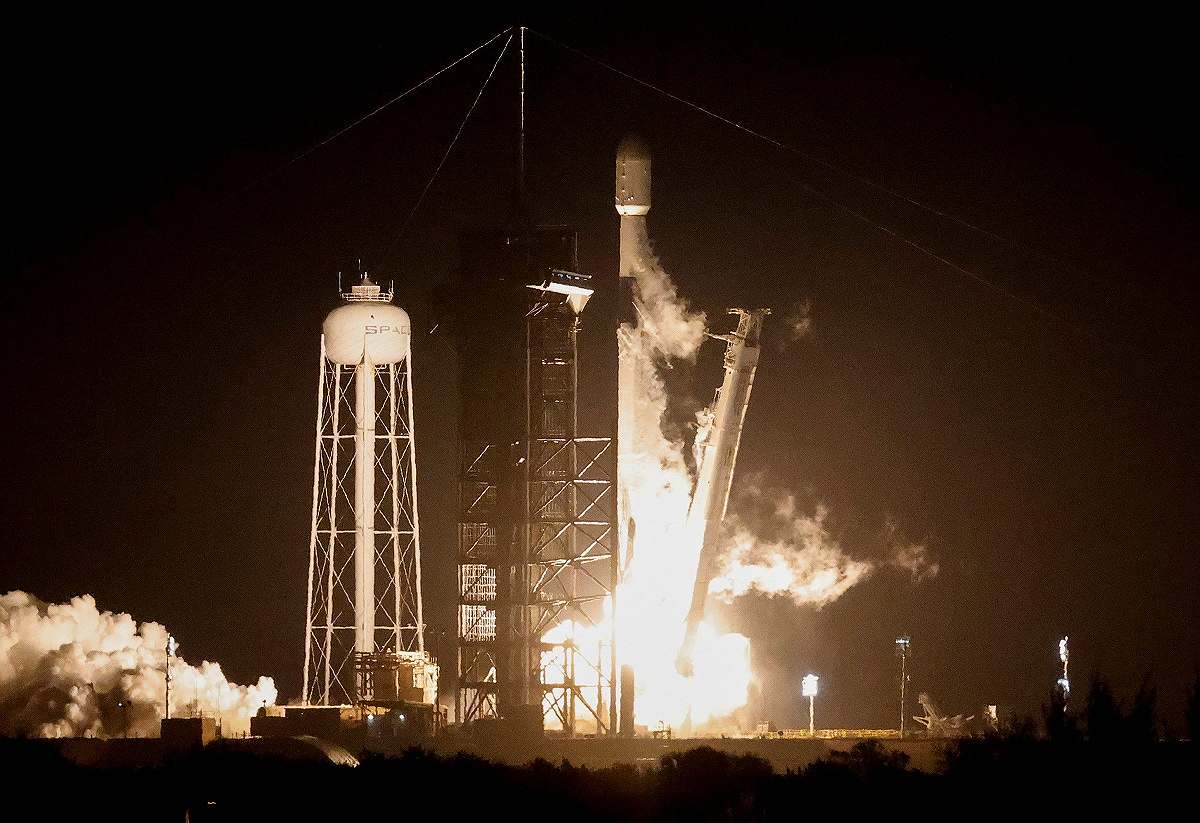
A SpaceX Falcon 9 rocket lifts off on the IM-1 mission with the Nova-C moon lander built and owned by Intuitive Machines from the Kennedy Space Center in Cape Canaveral, Florida, U.S., February 15, 2024.
13:01 JST, February 16, 2024
CAPE CANAVERAL, Florida, Feb 15 (Reuters) – A moon lander built by Houston-based aerospace company Intuitive Machines was launched from Florida early on Thursday on a mission to conduct the first U.S. lunar touchdown in more than a half century and the first by a privately owned spacecraft.
The company’s Nova-C lander, dubbed Odysseus, lifted off shortly after 1 a.m. EST (0600 GMT) atop a two-stage Falcon 9 rocket flown by Elon Musk’ SpaceX from NASA’s Kennedy Space Center in Cape Canaveral.
A live NASA-SpaceX online video feed showed the two-stage, 25-story rocket roaring off the launch pad and streaking into the dark sky over Florida’s Atlantic coast, trailed by a fiery yellowish plume of exhaust.
About 48 minutes after launch, the six-legged lander was shown being released from Falcon 9’s upper stage about 139 miles above Earth and drifting away on its voyage to the moon.
“IM-1 Odysseus lunar lander separation confirmed,” a mission controller was heard saying.
Moments later, mission operations in Houston received its first radio signals from Odysseus as the lander began an automated process of powering on its systems and orienting itself in space, according to webcast commentators.
Although considered an Intuitive Machines mission, the IM-1 flight is carrying six NASA payloads of instruments designed to gather data about the lunar environment ahead of NASA’s planned return of astronauts to the moon later this decade.
Thursday’s launch came a month after the lunar lander of another private firm, Astrobotic Technology, suffered a propulsion system leak on its way to the moon shortly after being placed in orbit on Jan. 8 by a United Launch Alliance (ULA) Vulcan rocket making its debut flight.
The failure of Astrobotic’s Peregrine lander, which was also flying NASA payloads to the moon, marked the third time a private company had been unable to achieve a “soft landing” on the lunar surface, following ill-fated efforts by companies from Israel and Japan.
Those mishaps illustrated the risks NASA faces in leaning more heavily on the commercial sector than it had in the past to realize its spaceflight goals.
Plans call for Odysseus to reach its destination after a weeklongflight, with a Feb. 22 landing at crater Malapert A near the moon’s south pole.
If successful, the flight would represent the first controlled descent to the lunar surface by a U.S. spacecraft since the final Apollo crewed moon mission in 1972, and the first by a private company.
The feat also would mark the first journey to the lunar surface under NASA’s Artemis moon program, as the U.S. races to return astronauts to Earth’s natural satellite before China lands its own crewed spacecraft there.
IM-1 is the latest test of NASA’s strategy of paying for the use of spacecraft built and owned by private companies to slash the cost of the Artemis missions, envisioned as precursors to human exploration of Mars.
By contrast, during the Apollo era, NASA bought rockets and other technology from the private sector, but owned and operated them itself.
NASA announced last month that it was delaying its target date for a first crewed Artemis moon landing from 2025 to late 2026, while China has said it was aiming for 2030.
Small landers such as Nova-C are expected to get there first, carrying instruments to closely survey the lunar landscape, its resources and potential hazards. Odysseus will focus on space weather interactions with the moon’s surface, radio astronomy, precision landing technologies and navigation.
Intuitive Machine’s IM-2 mission is scheduled to land at the lunar south pole in 2024, followed by an IM-3 mission later in the year with several small rovers.
Last month, Japan became the fifth country to place a lander on the moon, with its space agency JAXA achieving an unusually precise “pinpoint” touchdown of its SLIM probe last month. Last year, India became the fourth nation to land on the moon, after Russia failed in an attempt the same month.
The United States, the former Soviet Union and China are the only other countries that have carried out successful soft lunar touchdowns. China scored a world first in 2019 by achieving the first landing on the far side of the moon.
"News Services" POPULAR ARTICLE
-

American Playwright Jeremy O. Harris Arrested in Japan on Alleged Drug Smuggling
-

Japan’s Nikkei Stock Average as JGB Yields, Yen Rise on Rate-Hike Bets
-

Japan’s Nikkei Stock Average Licks Wounds after Selloff Sparked by BOJ Hike Bets (UPDATE 1)
-

Japanese Bond Yields Zoom, Stocks Slide as Rate Hike Looms
-

Japan’s Nikkei Stock Average Buoyed by Stable Yen; SoftBank’s Slide Caps Gains (UPDATE 1)
JN ACCESS RANKING
-

Keidanren Chairman Yoshinobu Tsutsui Visits Kashiwazaki-Kariwa Nuclear Power Plant; Inspects New Emergency Safety System
-

Imports of Rare Earths from China Facing Delays, May Be Caused by Deterioration of Japan-China Relations
-

University of Tokyo Professor Discusses Japanese Economic Security in Interview Ahead of Forum
-

Japan Pulls out of Vietnam Nuclear Project, Complicating Hanoi’s Power Plans
-

Govt Aims to Expand NISA Program Lineup, Abolish Age Restriction























